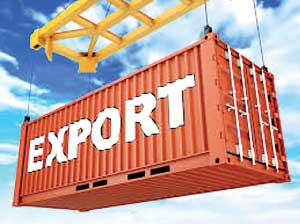Tuesday Mar 11, 2025
Tuesday Mar 11, 2025
Monday, 19 June 2017 00:03 - - {{hitsCtrl.values.hits}}
 Reviving a talk not walked for years
Reviving a talk not walked for years
Since liberalising the economy for export-led growth in 1977 by President J.R Jayawardena with many positive spinoffs such as free trade zones and expanding Colombo Port, Sri Lanka for years have lost its glory as a manufacturing-based export economy. By 2015 the contribution to the GDP from exports had dropped to a mere 15% as the focus towards export-led economy was a slogan for many years without concrete action.
As the export sector deteriorated, thousands of employable and trainable people left the country seeking employment in the Middle East for low paying cheap labour, the number is now estimated to be around two million and mainly rural women. So much so some politicians were bragging about dollar income earned through near slave labour in some parts of the world and on one hand distorting the culture and social networks of Sri Lanka. Probably this social destruction has caused Sri Lanka to be a nation that has lost direction whilst everything was pointed towards the northern conflict by most politicians.
As the first country in South Asia that opened its economy 40 years ago, we are still struggling to compete, diversify and expand exports as serious deterioration of the sector has driven many entrepreneurs away from getting into the sector and the spirit and the moral of the sector has been very low.
Making things worse in the recent past products such as fisheries exports that were rapidly growing due to GSP+ in 2005 got a double hit with the EU ban on imports from Sri Lanka along with the withdrawal of GSP+ which hit a cross section of the small basket of Sri Lankan exports that entered the EU market. Reviving the sector is an utmost importance now as the country is trapped in a debt crisis as we never could build our reserves through real hard-earned dollars from sectors such as exports.
The new effort on exports
Due credit must be given to the newly-elected Government for bringing back the needed focus on exports, re-engaging the EU and lifting the fisheries ban and the restoration of the GSP+ and creating a new opportunity to enter EU market with the level playing field with similar export economies of Asia. We must understand and appreciate as the process of such market access is not easy and many in the Government starting from the Prime Minister have put a lot of effort.
The current negotiations for comprehensive FTAs with India, China and Singapore with further possibility with Bangladesh and Japan is promising and indicates that the Government is on the right track towards expanding exports by creating new market access and laying the ground for a conducive environment.
Boost for the apparel industry
Certainly the readymade apparel industry of this country has held the export industry during hard times by contributing nearly 50% of the export earnings for a considerable time, and with GSP+ restoration the dynamic and innovative sector will certainly try to expand the sector over the coming years. Ironically the Government of President Maithripala Sirisena and Prime Minster Ranil Wickremesinghe restored the GSP+ after 25 years since then President Ranasinghe Premadasa introduced the 200 garment factories project when Prime Minister Ranil Wickremesinghe was Minister of Industries in 1992.
The 200GFP project was highly criticised by many and laughed at, it was the successful vision to take the BOI zones beyond borders to the rural masses to increase manufacturing, create jobs and help reduce poverty in the country. The contribution of the apparel sector to this country to move up the income ladder and help to become a lower middle-income status has never been properly appreciated. Only the negative factors have been highlighted by the media and critics. As we have a new vision to take Sri Lanka once again to an export-led economy, the apparel industry will still be a significant player in the years to come.
Driving the new vision
The Government’s effort to develop a new National Export Strategy (NES) along with the Export Development Board (EDB) and all stakeholders is very encouraging and a positive development. However, the ordinary citizen, the educated middle class or some in the export sector at large are not aware of the efforts put into restructuring the export industry. The fundamental weakness has been lack of publicity and communication for things that are being done for the benefit of the sector.
The Ministry has taken steps with International Trade Centre (ITC) to come up with a gap analysis to develop the NES, they have engaged with the private sector and chambers to work towards a strategic plan which obliviously will take time to see the results, but the important aspect of it is that the EDB has taken the initiative to diversify the export sector by understanding the value chain challenges and changes considering Sri Lanka’s labour constrains faced by the current industries.
Labour shortage is one of the biggest complaints that we hear from the exporters from all corners. As expressed by the Prime  Minister recently, if the export industry must sustain, it will have to look at a higher wage structure and adapt technology and new products where more value addition and innovation could target better revenue. This needs a multi-direction approach including training and development of skills, international marketing and policy reforms for facilitation of exports, EDB has to play its past glory performance and be the central nerve centre if NES recommendations are to succeed.
Minister recently, if the export industry must sustain, it will have to look at a higher wage structure and adapt technology and new products where more value addition and innovation could target better revenue. This needs a multi-direction approach including training and development of skills, international marketing and policy reforms for facilitation of exports, EDB has to play its past glory performance and be the central nerve centre if NES recommendations are to succeed.
The fact is that for over two decades the country has gone backwards in the export industry compared to many other countries in Asia, therefore it will be a challenge for all who believe in exports to attract new investment and develop and diversify the sector. One crucial element is consistency, predictability and commitment on a five-year plan to facilitate exports. This should be the focus of the policymakers in the upcoming budget and incorporate the recommendations of the NES and implement trade facilitation measures, where a cross section of Government and private sector can work towards one goal, that is to be realistic where we target export-led contribution of around 30% of GDP by 2025 to the economy, rather than spelling out numbers of $ 20 billion and $50 billion, without a proper action plan.
Once again appreciating the challenging work done by the Government and EDB, I call upon EDB not to leave out the good things of the past such as the ‘Exporters Forum’ and to have it at least once in three months with the Prime Minister to sort out current issues whilst we draw the larger picture with the NES, as I always believe that there is “no need to reinvent the wheel, just re-engineer it!”
(The writer is the CEO of Shippers’ Academy Colombo, an economics graduate from the Connecticut State University USA, and Immediate Past Secretary General of the Asian Shippers’ Council.)
Discover Kapruka, the leading online shopping platform in Sri Lanka, where you can conveniently send Gifts and Flowers to your loved ones for any event including Valentine ’s Day. Explore a wide range of popular Shopping Categories on Kapruka, including Toys, Groceries, Electronics, Birthday Cakes, Fruits, Chocolates, Flower Bouquets, Clothing, Watches, Lingerie, Gift Sets and Jewellery. Also if you’re interested in selling with Kapruka, Partner Central by Kapruka is the best solution to start with. Moreover, through Kapruka Global Shop, you can also enjoy the convenience of purchasing products from renowned platforms like Amazon and eBay and have them delivered to Sri Lanka.
Discover Kapruka, the leading online shopping platform in Sri Lanka, where you can conveniently send Gifts and Flowers to your loved ones for any event including Valentine ’s Day. Explore a wide range of popular Shopping Categories on Kapruka, including Toys, Groceries, Electronics, Birthday Cakes, Fruits, Chocolates, Flower Bouquets, Clothing, Watches, Lingerie, Gift Sets and Jewellery. Also if you’re interested in selling with Kapruka, Partner Central by Kapruka is the best solution to start with. Moreover, through Kapruka Global Shop, you can also enjoy the convenience of purchasing products from renowned platforms like Amazon and eBay and have them delivered to Sri Lanka.